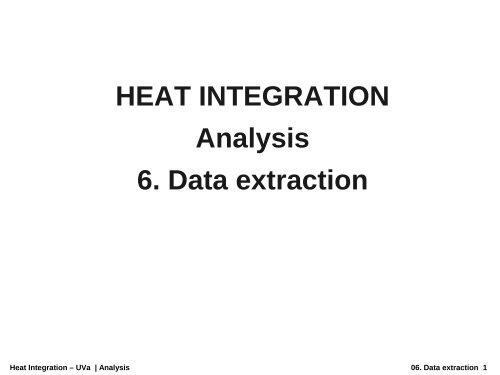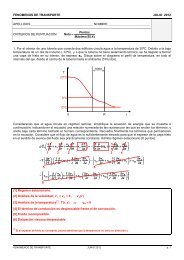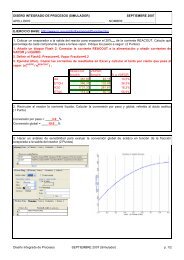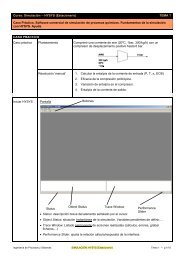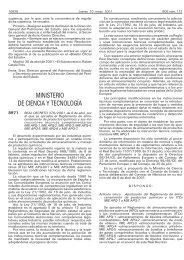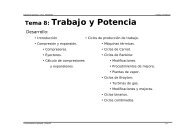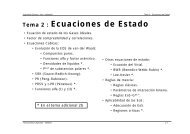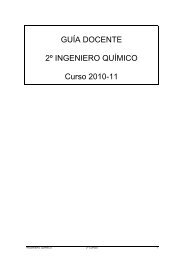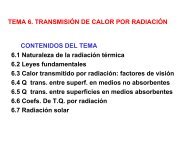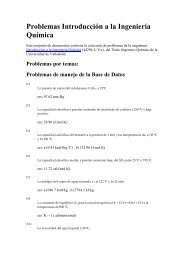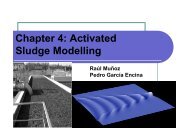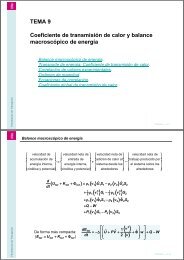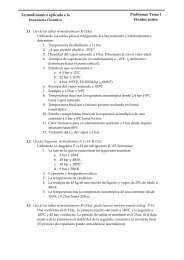HEAT INTEGRATION Analysis 6. Data extraction - IqTMA-UVa
HEAT INTEGRATION Analysis 6. Data extraction - IqTMA-UVa
HEAT INTEGRATION Analysis 6. Data extraction - IqTMA-UVa
You also want an ePaper? Increase the reach of your titles
YUMPU automatically turns print PDFs into web optimized ePapers that Google loves.
<strong>HEAT</strong> <strong>INTEGRATION</strong><br />
<strong>Analysis</strong><br />
<strong>6.</strong> <strong>Data</strong> <strong>extraction</strong><br />
Heat Integration – <strong>UVa</strong> | <strong>Analysis</strong> 0<strong>6.</strong> <strong>Data</strong> <strong>extraction</strong> 1
Outline<br />
<strong>Data</strong> <strong>extraction</strong><br />
Required data<br />
Rules and guides (1 to 5)<br />
Process modification<br />
Plus/minus principle<br />
Heat Integration – <strong>UVa</strong> | <strong>Analysis</strong> 0<strong>6.</strong> <strong>Data</strong> <strong>extraction</strong> 2
<strong>Data</strong> <strong>extraction</strong><br />
To pull out data from the PFD and include it into the problem<br />
General principles:<br />
it's about disconnecting the existing solution (in order to reconnect it)<br />
to extract only requirements<br />
don't extract mandatory features: leave it as they are<br />
extract heat (and cold) that can actually be used by other streams<br />
Poor data <strong>extraction</strong> can lead to two extremes:<br />
thinking that process is at its optimum (if maintaining excessive features)<br />
over-estimating the room for improvement (if extracting too much)<br />
Heat Integration – <strong>UVa</strong> | <strong>Analysis</strong> 0<strong>6.</strong> <strong>Data</strong> <strong>extraction</strong> 3
Required information/data<br />
As a minimum: Problem Table<br />
Supply and target temperatures<br />
Stream heating and cooling data: enthalpies and/or mCps<br />
Information on existing/planned utility system<br />
Information on costs:<br />
Energy (utilities)<br />
Equipment<br />
Heat exchangers material, pressures, type...<br />
Utility system devices<br />
General and background information on the process<br />
Heat Integration – <strong>UVa</strong> | <strong>Analysis</strong> 0<strong>6.</strong> <strong>Data</strong> <strong>extraction</strong> 4
Rules - Guides (1)<br />
Doesn't extract / doesn't include in the problem:<br />
Mandatory parts / parts that cant' be changed<br />
e.g.: Using quenching steam generation in a reactor<br />
This heat cannot be used in other way<br />
True utility streams<br />
(utility that can be replaced by other)<br />
Quenching (steam generation)<br />
Cold shots for reactor hot spots control<br />
Steam in a shift reactor (to enhance the shift process)<br />
Steam injection for steam distillation (different from direct steam<br />
to reboil the column - only heat transfer)<br />
Heat Integration – <strong>UVa</strong> | <strong>Analysis</strong> 0<strong>6.</strong> <strong>Data</strong> <strong>extraction</strong> 5
Rules - Guides (2)<br />
Doesn't extract / include in the problem:<br />
Linked or chained Energy flows<br />
Reaction (most cases)<br />
Compression / expansion ΔH can't be integrated<br />
Heat Integration – <strong>UVa</strong> | <strong>Analysis</strong> 0<strong>6.</strong> <strong>Data</strong> <strong>extraction</strong> 6
Rules - Guides (3)<br />
Don't maintain unnecessary / too detailed features<br />
Extend (conceptual) streams as much as possible (energy streams are not<br />
material streams)<br />
NO<br />
YES<br />
T1 T2 dH T1 T2 dH<br />
------------------- -------------------<br />
35.0 45.5 +191 35.0 130.0 +1720<br />
120.0 55.0 -191 120.0 55.0 -191<br />
45.5 91.5 +832 210.0 65.5 -832<br />
210.0 65.5 -832 -------------------<br />
91.5 130.0 +697<br />
-------------------<br />
Long no-linear streams can be linearized by segments for calculation<br />
purposes, but conceptual stream is one. Linearization is just a calculation trick<br />
Correct, if possible up-down-up temperatures (heating-cooling-heating)<br />
T1 T2 dH T1 T2 dH<br />
-------------------- -------------------<br />
35.0 150.0 +80 35.0 130.0 +6<strong>6.</strong>1<br />
150.0 180.0 +20.9 -------------------<br />
180.0 130.0 -34.8<br />
--------------------<br />
NO<br />
YES<br />
Heat Integration – <strong>UVa</strong> | <strong>Analysis</strong> 0<strong>6.</strong> <strong>Data</strong> <strong>extraction</strong> 7
Rules - Guides (4)<br />
Look at hidden (direct) heat exchange<br />
Mixing streams<br />
Injecting streams (e.g.: process water)<br />
Heating/cooling opportunities are lost<br />
Heat exchange is been condemned to this configuration (no mandatory)<br />
Can involve heat transfer across the pinch<br />
Calculating targets with/without mixing assess <strong>extraction</strong> or not<br />
Heat Integration – <strong>UVa</strong> | <strong>Analysis</strong> 0<strong>6.</strong> <strong>Data</strong> <strong>extraction</strong> 8
Mixing calculation (1)<br />
[Approximations: constant mCp, no mixing effects, no phase change]<br />
From mCp :<br />
mC P1 T 3 −T 1 =−mC P2 T 3 −T 2 <br />
T 3 = mC P1T 1 mC P2 T 2<br />
= 428,6 K<br />
mC P1 mC P2<br />
Duty 1 = mC P1 T 3 −T 1 =−10286 kW<br />
Duty 2 = mC P2 T 3 −T 2 = 10286 kW<br />
mC P1 = mC P3 −mC P2 = 90 kW K<br />
Duty 2 = mC P2 T 3 −T 2 = 12000 kW =−Duty 1<br />
T 1 = T 3 − Duty 1<br />
mC P1<br />
= 31<strong>6.</strong>7 K<br />
Duty 1 = mC P1 T 3 −T 1 = −12000 kW<br />
Valid for absolute or relative (ºC or ºF) temperature<br />
Heat Integration – <strong>UVa</strong> | <strong>Analysis</strong> 0<strong>6.</strong> <strong>Data</strong> <strong>extraction</strong> 9
Mixing calculation (2)<br />
[Approximations: constant mCp, no mixing effects, no phase change]<br />
From enthalpies:<br />
T REF = T 2 H 1,rel = H 1 −H 2 = 1400 kJ<br />
kg , H 2,rel = 0 kJ<br />
kg<br />
C P1 =<br />
H 1,rel 1400 kJ /kg<br />
= = 4.667 kJ<br />
T 1 −T 2 300 K<br />
kg K<br />
mC P1 = m˙<br />
1 ∗C P1 = 1 kg s 4.667 kJ<br />
kg K = 4.667 kW K<br />
Duty 1 = mC P1 T 3 −T 1 = 4.667 kW 400 K −600 K = −933.3 kW<br />
K<br />
Duty 2 = −Duty 1 = 933.3 kW<br />
Just a rough approximation<br />
Heat Integration – <strong>UVa</strong> | <strong>Analysis</strong> 0<strong>6.</strong> <strong>Data</strong> <strong>extraction</strong> 10
Rules - Guides (5)<br />
Extract/approximate non-linear streams the safe side<br />
SAFE<br />
DANGEROUS<br />
DANGEROUS<br />
SAFE<br />
Hot streams hotter / Cold streams colder than approximations<br />
Heat Integration – <strong>UVa</strong> | <strong>Analysis</strong> 0<strong>6.</strong> <strong>Data</strong> <strong>extraction</strong> 11
Process modification<br />
Changing the material and energy balances to reduce<br />
requirements in utility / equipment<br />
Hard and soft / flexible and rigid constraints.<br />
P/T vaporization/condensation<br />
T of streams to storage<br />
Column reboiler/condenser P/T<br />
Process modification possibilities<br />
Distillation column operating pressure<br />
Feed vaporization pressure<br />
Pump-around flow rates<br />
Reactor conversion / recycle<br />
Heat Integration – <strong>UVa</strong> | <strong>Analysis</strong> 0<strong>6.</strong> <strong>Data</strong> <strong>extraction</strong> 12
Plus-minus principle 1<br />
Identify/characterize changes in PFD<br />
(operation conditions) that improve energy<br />
performance<br />
Good modifications:<br />
Those that decreases hot utility:<br />
Increasing hot stream duty above the pinch<br />
Decreasing cold stream duty above the pinch<br />
Those that decreases cold utility:<br />
Decreasing hot stream duty below the pinch<br />
Increasing cold stream duty bellow the pinch<br />
Heat Integration – <strong>UVa</strong> | <strong>Analysis</strong> 0<strong>6.</strong> <strong>Data</strong> <strong>extraction</strong> 13
Plus-minus principle 2<br />
Also changing Ts<br />
Changes of T confined to one side of the pinch<br />
have no effects on energy targets<br />
Changes of T across the pinch can have effects<br />
on energy targets (if shift duty across to)<br />
Shift hot stream duty from below to above the<br />
pinch / Shift cold stream duty from below to<br />
below the pinch<br />
As a general rule: made hot streams hotter and<br />
cold streams colder<br />
Can shift duty the right way<br />
Widen ΔT between curves/improve driving forces<br />
Heat Integration – <strong>UVa</strong> | <strong>Analysis</strong> 0<strong>6.</strong> <strong>Data</strong> <strong>extraction</strong> 14


